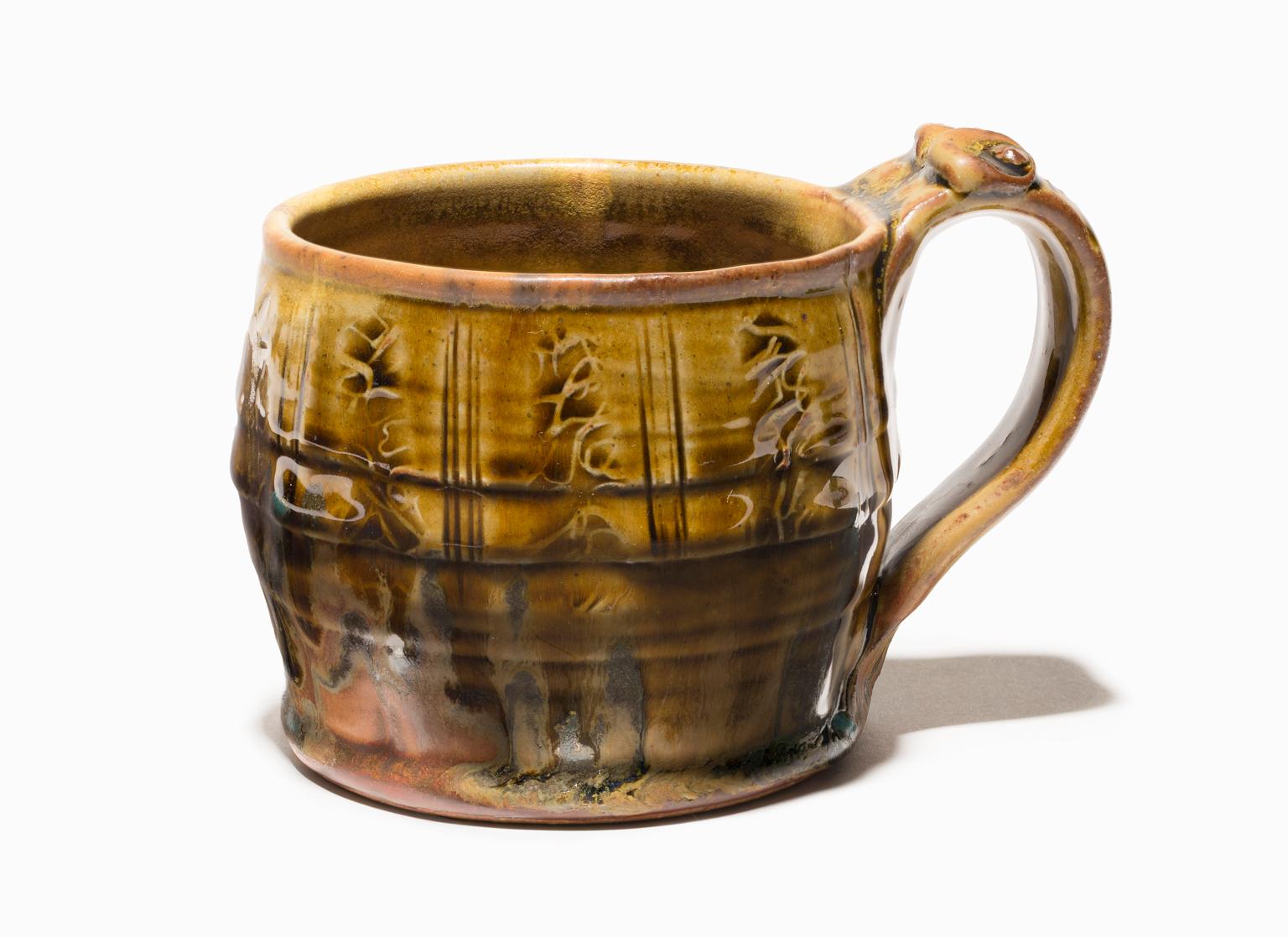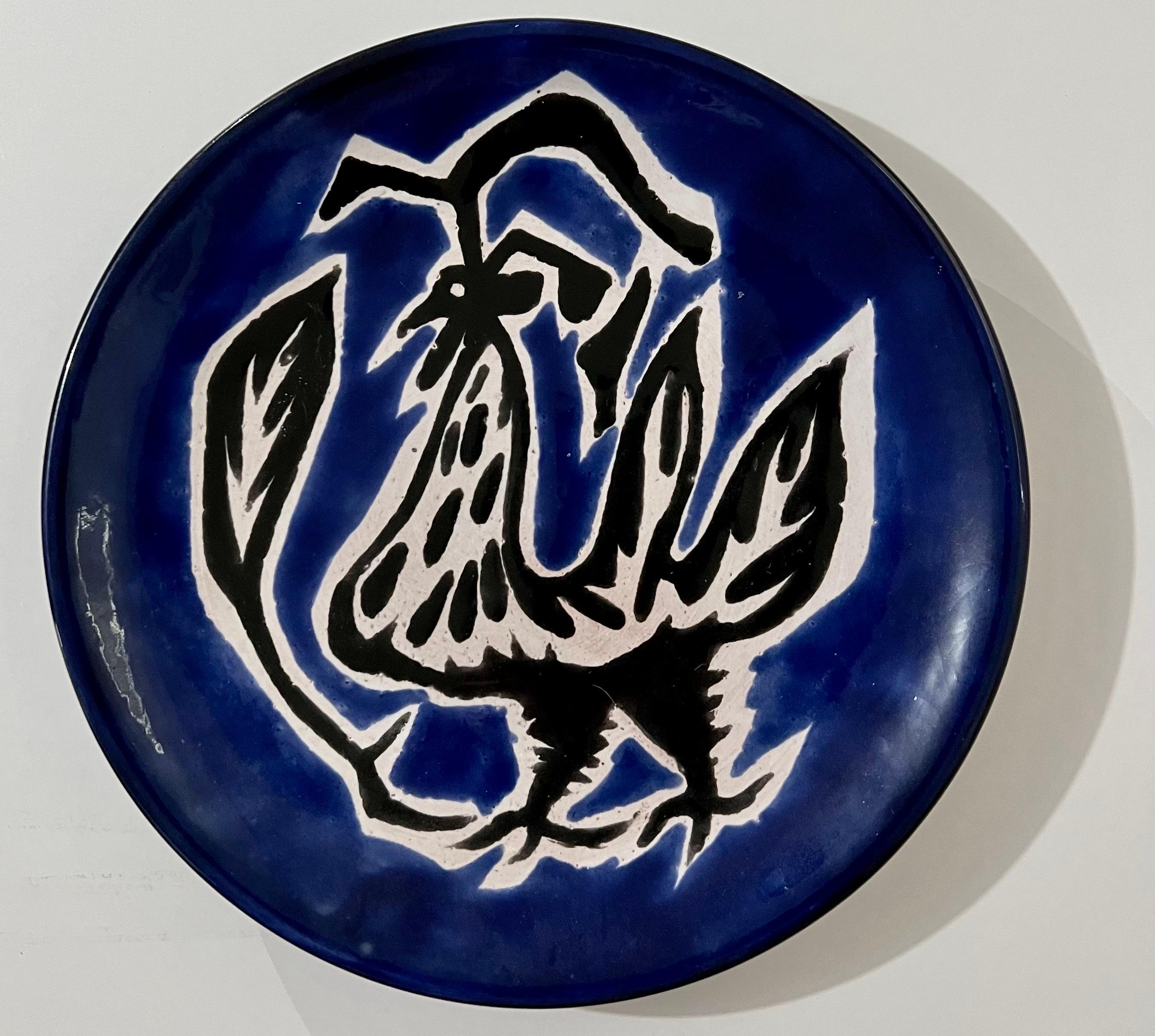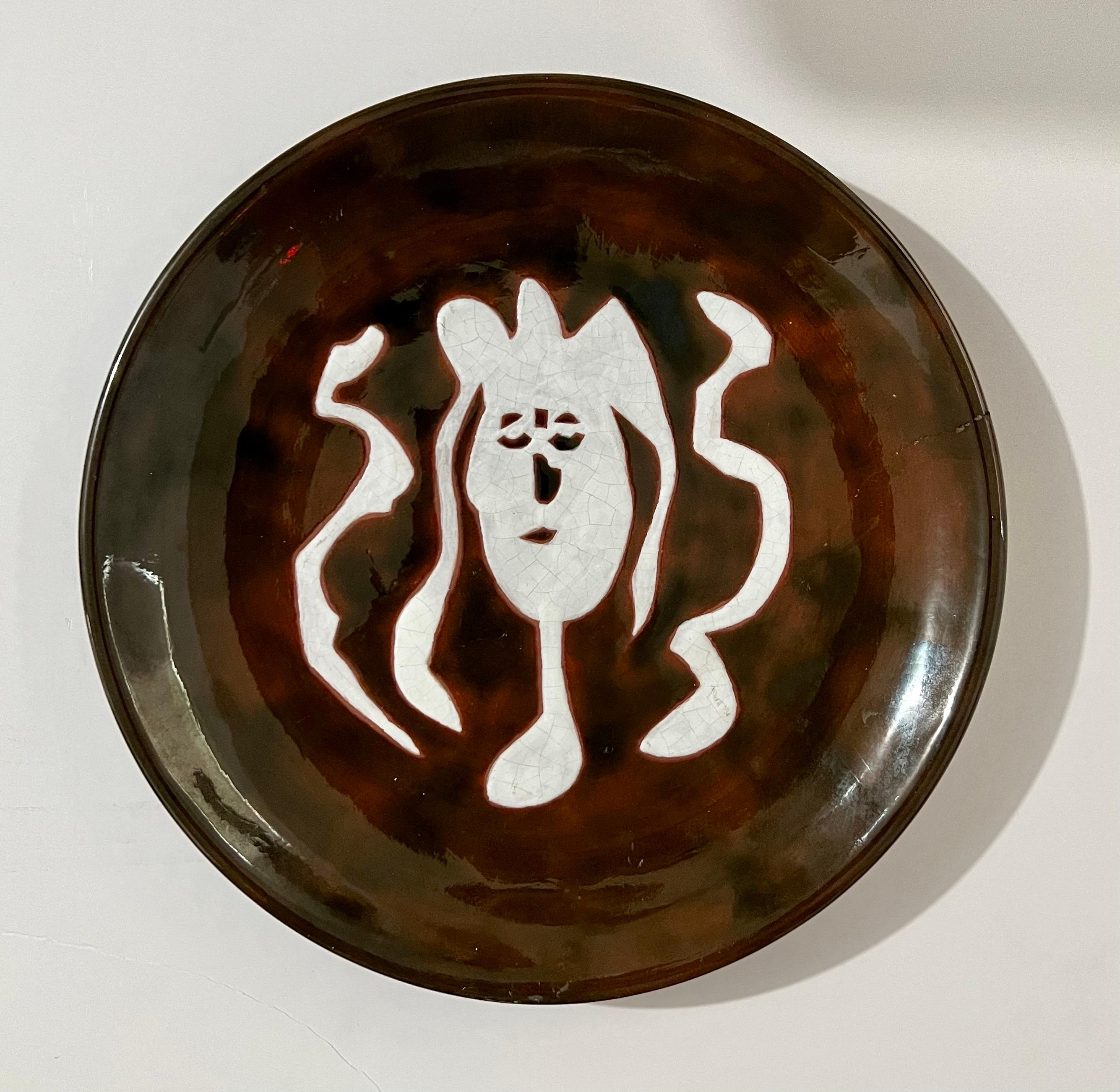Items Similar to "Monumental Chalice" Rare Ceramic Turquoise Green Red Graphic Signed
Want more images or videos?
Request additional images or videos from the seller
1 of 7
Guido Gambone"Monumental Chalice" Rare Ceramic Turquoise Green Red Graphic Signed 1950
1950
About the Item
“Monumental Chalice” is a stunning rare monumental ceramic chalice by the world re-known Italian potter Guido Gambone. The shape is light and delicate with a comfortable weight. Turquoise and green glaze the piece in a lovely mixture of colors with red iron oxide design to the lip, the foot and the surrounding bowl of the chalice. Made in 1950 it has no cracks, chips or repairs. You could say the geometric design on this piece, which Gambone created nearly 60 years ago, is current once again. The glaze is pristine and the piece looks as though it has just emerged from the kiln.
The surface design is beautifully integrated with the shape of the chalice and gives a striking contrast to the predominate glaze colors. It is correctly signed on the bottom "Gambone Italy" and with the donkey symbol. Just a fabulous piece!! This is an excellent example of Gambone's iconic work, in fabulous condition. This chalice would look so great in a mid-century modern decor, in a Hollywood Regency room, in a Paris apartment or in a charming townhouse.
- Creator:Guido Gambone (1909 - 1969)
- Creation Year:1950
- Dimensions:Height: 7.5 in (19.05 cm)Width: 7 in (17.78 cm)
- Medium:
- Movement & Style:
- Period:
- Condition:
- Gallery Location:Detroit, MI
- Reference Number:1stDibs: LU128615839441
About the Seller
5.0
Vetted Seller
These experienced sellers undergo a comprehensive evaluation by our team of in-house experts.
Established in 2014
1stDibs seller since 2019
95 sales on 1stDibs
Typical response time: 4 hours
- ShippingRetrieving quote...Ships From: Detroit, MI
- Return PolicyA return for this item may be initiated within 14 days of delivery.
More From This SellerView All
- John Glick Plum Tree Pottery , Stoneware Mug, Deep Earth Tones, GlazedLocated in Detroit, MI“Untitled” ceramic, is an example of the kind of work by which John Glick became so famous. He was seduced by the effects of the reduction kiln, which decreased the levels of oxygen during firing, inducing the flame to pull oxygen out of the clay and glazes changing the colors of the glazes depending on their iron and copper content. In this way he achieved the rich gradients of ochre and umber and variations in stippling and opacity. This piece is signed on the bottom and can be found on page 129, plate #236 in “John Glick: A Legacy in Clay.” John was an American Abstract Expressionist ceramicist born in Detroit, MI. Though open to artistic experimentation, Glick was most influenced by the styles and aesthetics of Asian pottery—an inspiration that shows in his use of decorative patterns and glaze choices. He has said that he is attracted to simplicity, as well as complexity: my work continually reflects my re-examination that these two poles can coexist… or not, in a given series. Glick also took influences from master potters of Japan, notably Shoji Hamada and Kanjrio Kawai, blending their gestural embellishments of simple forms with attitudes of Abstract Expressionism. He was particularly drown to the work of Helen Frankenthaler whose soak-stain style resonated with Glick’s multi-layered glaze surfaces, which juxtaposed veils of atmospheric color with gestural marks and pattern. He spent countless hours developing and making his own tools in order to achieve previously unseen results in his work with clay and glaze. Glick’s “Plum Tree Pottery...Category
Late 20th Century American Modern More Art
MaterialsStoneware, Glaze
- John Glick Plum Street Pottery Reduction Fired Shino Glaze Cup Published in BookLocated in Detroit, MI“Untitled” ceramic, is an example of the kind of work by which John Glick became so famous. He was seduced by the effects of the reduction kiln, which decreased the levels of oxygen during firing, inducing the flame to pull oxygen out of the clay and glazes changing the colors of the glazes depending on their iron and copper content. In this way he achieved the rich gradients of ochre and umber and variations in stippling and opacity. This piece is signed on the bottom and can be found on page 92, plate #125 in “John Glick: A Legacy in Clay.” John was an American Abstract Expressionist ceramicist born in Detroit, MI. Though open to artistic experimentation, Glick was most influenced by the styles and aesthetics of Asian pottery—an inspiration that shows in his use of decorative patterns and glaze choices. He has said that he is attracted to simplicity, as well as complexity: my work continually reflects my re-examination that these two poles can coexist… or not, in a given series. Glick also took influences from master potters of Japan, notably Shoji Hamada and Kanjrio Kawai, blending their gestural embellishments of simple forms with attitudes of Abstract Expressionism. He was particularly drown to the work of Helen Frankenthaler whose soak-stain style resonated with Glick’s multi-layered glaze surfaces, which juxtaposed veils of atmospheric color with gestural marks and pattern. He spent countless hours developing and making his own tools in order to achieve previously unseen results in his work with clay and glaze. Glick’s “Plum Tree Pottery...Category
1990s American Modern More Art
MaterialsStoneware, Glaze
- "Untitled" Ceramic Vase with Etched Figures, Green Glaze, Signed on BottomLocated in Detroit, MISALE ONE WEEK ONLY Douglas’s etched ceramic vase in a rich earthy green glaze expresses the Mid-Century Modern style of simplicity of lines, forms and color. Despite its formal shap...Category
Mid-20th Century American Modern More Art
MaterialsCeramic, Glaze
- "Mid-Century Modern Red Vase" Burnished Red, Black Stripe, CeramicLocated in Detroit, MIThe Mid-Century Modern red vase by Dante Baldelli is an elegant example of the work his studio could produce for the consumer to enhance the décor of th...Category
Mid-20th Century Modern More Art
MaterialsCeramic, Glaze
- John Glick Plum Street Pottery Glazed Bowl Reduction FiredLocated in Detroit, MI"Untitled" is a stoneware piece with the decorative layer of the rich toned glazes and markings that John was so well-known for. Each piece that John produced was unique. The lip on this piece is slightly scalloped and the shape is removed from the boring circular to mimic a gentle geometric design. He was seduced by the effects of the reduction kiln, which decreased the levels of oxygen during firing, inducing the flame to pull oxygen out of the clay and glazes changing the colors of the glazes depending on their iron and copper content. In this way he achieved the rich gradients of ochre and umber and variations in stippling and opacity. This piece is signed and stamped on the bottom. John was an American Abstract Expressionist ceramicist born in Detroit, MI. Though open to artistic experimentation, Glick was most influenced by the styles and aesthetics of Asian pottery—an inspiration that shows in his use of decorative patterns and glaze choices. He has said that he is attracted to simplicity, as well as complexity: my work continually reflects my re-examination that these two poles can coexist… or not, in a given series. Glick also took influences from master potters of Japan, notably Shoji Hamada and Kanjrio Kawai, blending their gestural embellishments of simple forms with attitudes of Abstract Expressionism. He was particularly drown to the work of Helen Frankenthaler whose soak-stain style resonated with Glick’s multi-layered glaze surfaces, which juxtaposed veils of atmospheric color with gestural marks and pattern. He spent countless hours developing and making his own tools in order to achieve previously unseen results in his work with clay and glaze. Glick’s “Plum Tree Pottery...Category
1970s American Modern Abstract Sculptures
MaterialsStoneware, Glaze
- Magnificent John Glick Plum Street Pottery "Scalloped Box" Glazed StonewareLocated in Detroit, MIThis magnificent "Scalloped Box" is a stoneware piece with decorative layers of rich toned glazes and markings that John was so well-known for. He was, also, known for the undulating lip lines on his exquisite boxes that fit together like a puzzle. Each piece that John produced was unique. He was seduced by the effects of the reduction kiln, which decreased the levels of oxygen during firing, inducing the flame to pull oxygen out of the clay and glazes thereby changing the colors of the glazes depending on their iron and copper content. In this way he achieved the rich gradients of ochre and umber and variations in stippling and opacity. This piece is signed and stamped on the bottom. John was an American Abstract Expressionist ceramicist born in Detroit, MI. Though open to artistic experimentation, Glick was most influenced by the styles and aesthetics of Asian pottery—an inspiration that shows in his use of decorative patterns and glaze choices. He has said that he is attracted to simplicity, as well as complexity: my work continually reflects my re-examination that these two poles can coexist… or not, in a given series. Glick also took influences from master potters of Japan, notably Shoji Hamada and Kanjrio Kawai, blending their gestural embellishments of simple forms with attitudes of Abstract Expressionism. He was particularly drown to the work of Helen Frankenthaler whose soak-stain style resonated with Glick’s multi-layered glaze surfaces, which juxtaposed veils of atmospheric color with gestural marks and pattern. He spent countless hours developing and making his own tools in order to achieve previously unseen results in his work with clay and glaze. Glick’s “Plum Tree Pottery...Category
Late 20th Century American Modern Abstract Sculptures
MaterialsStoneware, Glaze
You May Also Like
- Vintage French Modernist Jean Lurcat Glazed Ceramic Art Plate Sant-Vicens FranceBy Jean LurçatLocated in Surfside, FLVintage Jean Lurcat glazed fired enamel wall plaque ceramic plate limited edition hand inscribed faience Ceramique Saint Vicens charger. It depicts a h...Category
Mid-20th Century Modern More Art
MaterialsCeramic, Glaze
- Vintage French Modernist Jean Lurcat Glazed Ceramic Art Plate Sant-Vicens FranceBy Jean LurçatLocated in Surfside, FLVintage Jean Lurcat glazed fired enamel wall plaque ceramic plate limited edition hand inscribed faience Ceramique Saint Vicens charger. It depicts a h...Category
Mid-20th Century Modern More Art
MaterialsCeramic, Glaze
- Vintage French Modernist Jean Lurcat Glazed Ceramic Art Plate Sant-Vicens FranceBy Jean LurçatLocated in Surfside, FLVintage Jean Lurcat glazed fired enamel wall plaque ceramic plate limited edition hand inscribed faience Ceramique Saint Vicens charger. It depicts hig...Category
Mid-20th Century Modern More Art
MaterialsCeramic, Glaze
- Cup with Patterns II (Hand-Painted, Gold Luster)By Melanie ShermanLocated in Kansas City, MOMelanie Sherman Cup with Patterns II (Hand-Painted, Gold Luster) Porcelain, Glaze, Porcelain Paint, Hand-made Vintage Decals, Gold Luster, Platinum Luster Year: 2022 Size: 3x3.25x3.2...Category
2010s Modern More Art
MaterialsLuster, Porcelain, Paint, Glaze, Underglaze
- Cup with Interior II (Hand-Painted, Gold Luster, Stereo, Couch, Flowers, Modern)By Melanie ShermanLocated in Kansas City, MOMelanie Sherman Cup with Interior II (Hand-Painted, Gold Luster, Stereo, Chair, Flowers) Porcelaneous Stoneware, Underglaze, Glaze, Porcelain Paint, Hand-made Vintage Decals, Gold Lu...Category
2010s Modern More Art
MaterialsLuster, Stoneware, Paint, Glaze, Underglaze
- Particle VIII (Eight)By Brady McLearenLocated in Kansas City, MOParticle VIII (Eight) Materials: Ceramic, glaze Year: 2016 The formal languages and frequencies that we find in the natural existence of the universe inform and inspire the investig...Category
2010s American Modern More Art
MaterialsCeramic, Glaze





